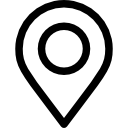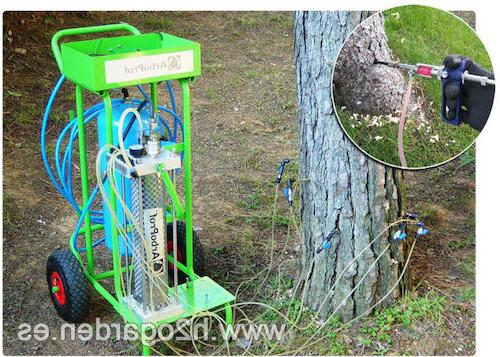







Plant Endotherapy
Inicio > Services> Plant Endotherapy
Plant endotherapy or tree endotherapy is an alternative method of phytosanitary treatment of urban trees with low environmental impact.
The treatment consists of the injection of a nutritional or phytosanitary substance directly into the vascular system of the tree using a professional Endotherapy machine. To do this, holes will be made in the trunk of the tree, connecting the trunk connectors and pressurizing the specific phytosanitary product for endotherapy towards the vascular vessels of the tree and its tissues, finally sealing all the holes produced to carry out the endotherapy with healing agent.
Endotherapy provides advantages over traditional aerial treatments, among which the absence of nebulization or atomization of chemical products in the environment as well as its harmlessness for the health of people (citizens and applicators) stand out. In addition, the treatment can be focused, thus avoiding indiscriminate treatments.
Through Endotherapy with Arboprof, not only can the most devastating pests be controlled, but also the diseases caused by foliar or vascular fungi. In addition, other applications, no less important, such as nutritional corrections, lack of iron or iron chlorosis, contributions of calcium, stimulants, potassium phosphites, contribution of nutrients and even growth stimulants for post transplants of emblematic or protected trees.
Application times vary depending on the species and dimension, as well as the type of porosity of the tree to be treated.

Gracias a este eficaz método sobre el propio árbol, podemos ofrecer altas garantías de éxito ya que al ser de aplicación directa se llega por capilarización a todas las partes del pino de una forma homogénea.
Compromiso H2OGarden
ECOLOGICAL FUMIGATIONS
At H2OGarden we are really aware of caring for the Environment, which is why we have committed to using only ecological products that do not harm our environment.
La antracnosis es un síntoma de una enfermedad causada por un hongo que se presenta en muchas plantas. Comienza a partir de la zona del cuello avanzando la infección hacia arriba. La planta se marchita y la enfermedad progresa rápidamente sobre todo en épocas lluviosas y con temperaturas altas. Se produce en las hojas, tallos y frutos siendo menos grave en estos últimos. Puede llegar a infectar varias plantas desde árboles hasta hierbas. Es una enfermedad que tiene la característica de extenderse con rapidez, por lo que debemos atacarla a tiempo si queremos que los vegetales sobrevivan.
This disease attacks young leaves, the petioles, the stems, the flowers and the fruits.
When the attack is severe, the affected areas begin to wither, stop their growth and defoliation occurs.
It is a polyphagous fungus. It is characterized by its appearance on the leaves and stems of red, brown, orange or yellowish pustules or bumps, which produce yellowish discolorations at the top. The severely affected leaves dry out and fall.
It attacks pine trees and mainly the stone tree, generating necrotic spots on the reddish-brown needles of the pine trees surrounded by dark dots. (ascocarps), drying out the needles that finally fall to the ground.
It is a fungus that attacks Elms, especially Ulmus. minor, the origin of its contagion being generally aerial, although it can also enter through roots connected between specimens, which is why it needs the help of elm scolytids for its dispersion. Initial infections begin in the branches, quickly spreading to the interior of the plant and causing the death of the tree.
It is one of the most destructive plant pathogens, causing massive death of absorbent roots, reducing the tree's ability to take water and nutrients from the soil, causing symptoms similar to those of drought. . This causes the foliage to become chlorotic and die.
It is a fungus that attacks any Cupressaceae (coniferous family), being of aerial origin, so it generally needs for their dispersion some vector, whether suckers or perforators. Initial infections in branches give rise to the so-called browning of Cupressaceae due to flashes, which as it advances towards the interior of the plant can lead to its death due to vascular collapse.
These are small beetles that develop between the bark and wood of pine trees. , on which they feed, causing the cutting of the sap-conducting vessels and finally the death of the trees, which end up drying out.
It is one of the causes of the "false autumn" of the horse chestnut trees. Between May and September the caterpillars of this small butterfly devour substances from the leaves, drying them out and thus forcing them to expire prematurely. In the medium term, and if the tree suffers early defoliation for several years, it can be lethal and dry out the chestnut tree.
They are sucking insects of the aphid genus. During the winter they are in the form of eggs and in the spring they hatch, settling along the trunk of the plant and feeding on its sap. This type of aphid secretes a honeydew (black, sticky substance) on which a fungus called "black mite" proliferates.
Both indoor and outdoor plants are prone to suffer this plague. They are sucking insects that can be identified with the naked eye. They bear that name because of the white, wool-like wax secretions. Both the larvae and adult females suck the leaves and tender shoots, thus retarding the growth of the plant, weakening it and exposing it to bacterial rot and fungal diseases.
Aparecen normalmente a mediados de la primavera en la copa del árbol recién brotada. Puede reproducirse hasta cuatro veces entre junio y octubre si hay altas temperaturas y falta de lluvias. Cuando los adultos hacen agujeros en las hojas, las larvas se comen con gran rapidez el parénquima verde, dejando a un lado las nerviaciones y la epidermis del reverso pudiendo llegar a defoliar completamente el olmo, debilitándolo y dejándolo expuesto al ataque de otros insectos perforadores o transmisores de hongos.
It mainly affects species such as oak, holm oaks, cork oaks; although it can also attack other hardwoods. Damage to the tree is caused as a result of the caterpillars feeding, eating the leaves and shoots. When defoliation is very intense, there can be a significant reduction in growth and even complete loss of fruit production, with the importance that this can represent.
Attack , mainly, to the palm family. The main damage it causes in palm trees is due to the boring activity of the larvae, which causes loss of vigor, yellowing, premature aging, tissue death, secondary infections, etc. The death of the palm tree can occur, especially in young palm trees, when the galleries destroy the apical meristem. It is difficult to detect its presence, except during periods of adult flight.
The red weevil beetle is a dangerous pest that has the ability to devour the inside of the trunk of the palm trees in a short time, weakening them and even causing their death. Females usually lay their eggs in palm trees that have, for example, poor pruning and have already begun to age, or in the leaves. When the eggs hatch, their larvae appear, and they will enter the trunk for a few days to survive. There they form a cocoon, obtaining the necessary nutrients so that the red weevil beetle can later emerge from the interior of the trunk. It is essential to prevent or detect this pest in time to avoid any type of danger since its presence in the palm trees means that, due to the weakening, they gradually give way, finally causing their possible collapse.
It feeds on the needles of pines and other conifers. It is the most important pest of pine forests and owes its name “Processionary” to the fact that it moves in a group in a line, like a procession. There are various types of treatment to control it, depending on the time of year in which it is carried out.
The eggs are milky white, turning yellow as they mature. At the beginning of spring, with the budding of the trees (sometimes before, even in flower), the nymphs from the winter eggs begin to emerge or the adults regain their activity, if they have spent the winter in this form, the which are reproduced to lay eggs. In any case, the emerging nymphs develop quickly by sucking the sap from the leaves, and after passing through five instars, the adults appear, normally from the end of April onwards.
The Aphid is one of the parasites that most frequently causes damage to plants, and its multiplication is very rapid. On the back of their abdomen they have a pair of cornicles through which they expel a sugary substance that serves as their defense. They suck the sap from the plant, producing a honeydew, weakening the plant, deforming the fruits and leaves and creating discoloration. In addition, they are vectors of viruses, favor the appearance of Sooty mold (sooty mold) and attract ants. They prefer tender tissues, which is why they are preferably found in the new shoots of leaves, flower buds of plants and bushes.
It feeds preferably on shady bananas, above which can constitute a serious threat. In summer it feeds on the sap of leaves and twigs, while in winter it hides under the bark. It can also be seen on mulberry, walnut, ash or lime trees. Damage is discoloration of the leaves, desiccation and defoliation; Some leaves take on a brown or black color due to burns due to the presence of the molasses they secrete and the secondary development on it of fungi known as Sooty molds.
We only use necessary technical and statistical cookies. If you continue browsing our website we will understand that you accept its use. Visit our cookie policy:Legal notice.